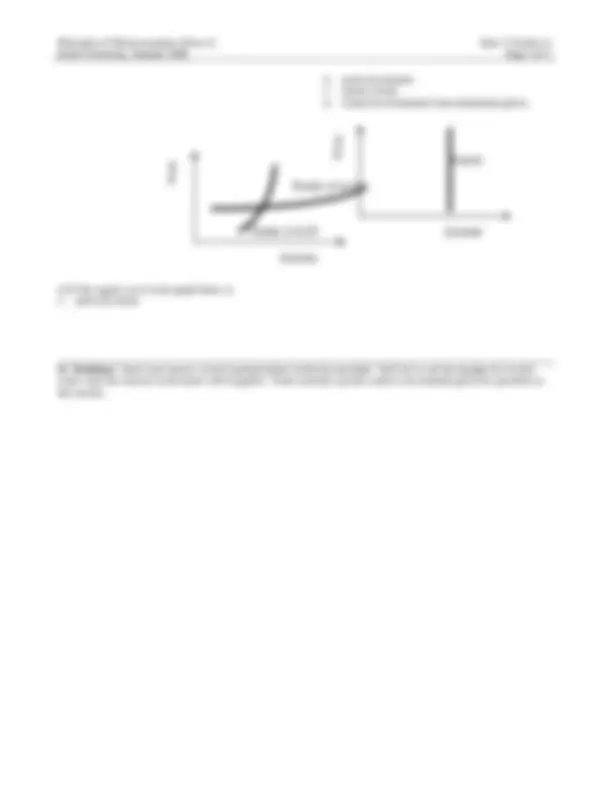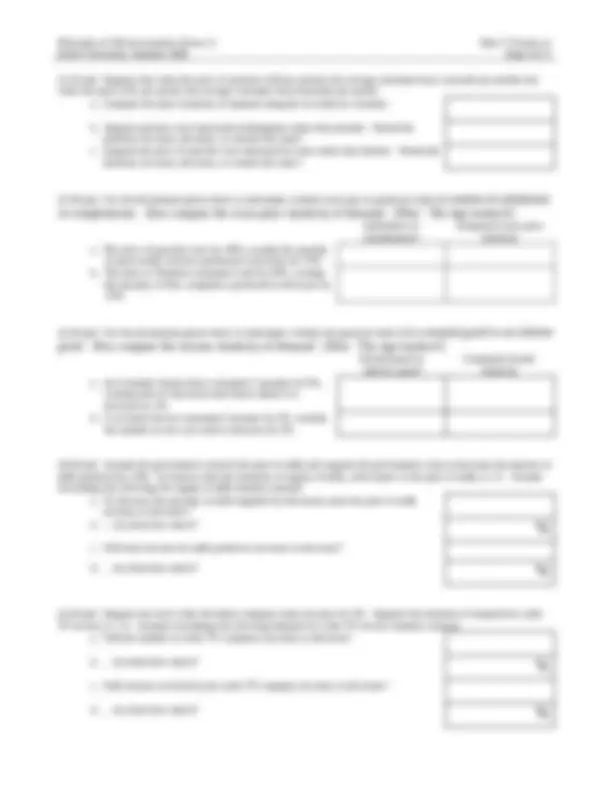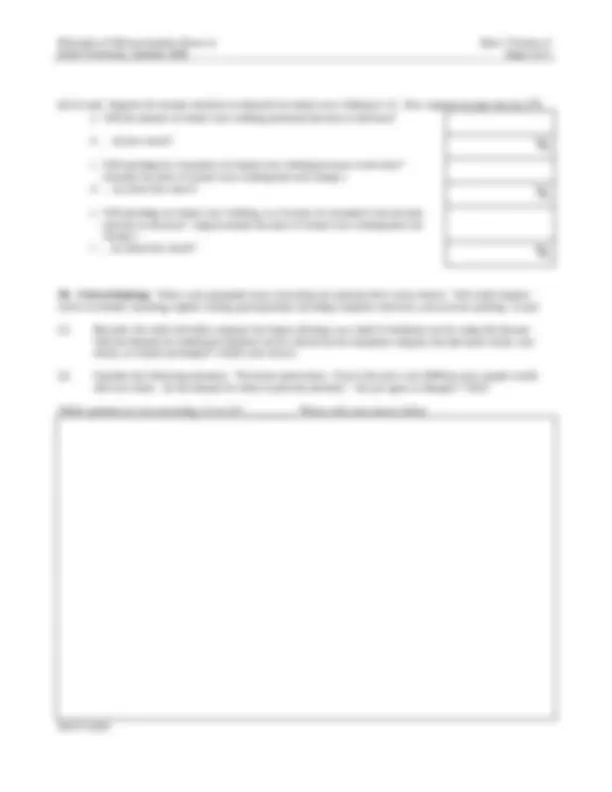





Study with the several resources on Docsity

Earn points by helping other students or get them with a premium plan


Prepare for your exams
Study with the several resources on Docsity

Earn points to download
Earn points by helping other students or get them with a premium plan
Community
Ask the community for help and clear up your study doubts
Discover the best universities in your country according to Docsity users
Free resources
Download our free guides on studying techniques, anxiety management strategies, and thesis advice from Docsity tutors
A quiz on elasticities in principles of microeconomics (econ 2) from drake university, summer 2006. The quiz includes multiple-choice questions and problems related to price elasticity of demand, income elasticity of demand, cross-price elasticity of demand, and elasticity of supply.
Typology: Quizzes
1 / 5

This page cannot be seen from the preview
Don't miss anything!




Principles of Microeconomics (Econ 2) Signature: Drake University, Summer 2006 William M. Boal Printed name:
INSTRUCTIONS: This exam is closed-book, closed-notes. Simple calculators are permitted, but graphing calculators or calculators with alphabetical keyboards are NOT permitted. Numerical answers, if rounded, must be correct to at least 3 significant digits. Point values for each question are noted in brackets. Maximum total points are 100. I. Multiple choice: Circle the one best answer to each question. [3 pts each: 45 pts total] (1) Which is a pure number, having no units of measure? a. price. b. elasticity. c. quantity. d. slope. (2) Which demand curve below is more elastic? a. Demand curve A. b. Demand curve B. c. Both have the same elasticity because they pass through the same point. d. Cannot be determined from the information given. (3) If there is more time for consumers to adjust to a product's price changes, that product’s demand will be a. more elastic. b. less elastic. c. perfectly elastic. d. Time for adjustment does not affect elasticity. (4) Which good is likely to have the least elastic demand? a. All juice. b. All frozen orange juice. c. Tropicana brand frozen orange juice. d. Demand for all three must have the same elasticity. Demand curve A Demand curve B Price Quantity
Drake University, Summer 2006 Page 2 of 5 (5) Elastic demand means that the price elasticity of demand is, in absolute value, a. exactly equal to zero. b. greater than zero but less than one. c. exactly equal to one. d. greater than one. (6) The demand curve in the graph below is a. perfectly elastic. b. perfectly inelastic. c. unitary elastic. d. Cannot be determined from information given. (7) A straight-line demand curve has a. zero price elasticity. b. constant (but non-zero) price elasticity. c. changing price elasticity. d. infinite priced elasticity. (8) Suppose that when the price of gasoline rises by 10%, every consumer everywhere buys 5% less gasoline. Now California has about 10 times more people than Iowa. Therefore the price elasticity of demand for gasoline in California is a. greater than the price elasticity of demand in Iowa. b. equal to the price elasticity of demand in Iowa. c. less than the price elasticity of demand in Iowa. d. cannot be determined from the information given. (9) Suppose the price elasticity of demand for electricity is –0.6. If the price of electricity is increased, the electricity utility’s revenue will a. decrease. b. remain constant. c. increase. d. fluctuate randomly. (10) Computer printers and ink cartridges are complements. Therefore, the cross-price elasticity of demand for ink cartridges, with respect to the price of printers, is surely a. positive. b. zero. c. negative. d. cannot be determined from information given. (11) The income elasticity of demand for beer is about 0.3. If a consumer's income increases, the share of the consumer's income devoted to spending on beer will a. decrease. b. remain constant. c. increase. d. fluctuate randomly. (12) Which is likely to have less elastic supply, original- edition books by Charles Dickens (a 19th century British novelist) or reprinted books by Charles Dickens? a. Original edition books. b. Reprinted books. c. Both have the same elasticity of supply because both are by Charles Dickens. d. Cannot be determined from the information given. (13) If producers can use commonly-available inputs— unskilled labor, off-the-shelf parts—then supply will be a. more elastic. b. less elastic. c. downward-sloping. d. Time for adjustment does not affect elasticity. (14) Which supply curve below is more elastic? a. Supply curve A. b. Supply curve B. c. Both have the same elasticity because they pass through the same point. d. Cannot be determined from the information given. Price Quantity Demand
Drake University, Summer 2006 Page 4 of 5 (1) [6 pts] Suppose that when the price of peaches is $3 per pound, the average consumer buys 2 pounds per month, but when the price is $1 per pound, the average consumer buys 8 pounds per month. a. Compute the price elasticity of demand using the so-called arc formula. b. Suppose peaches were measured in kilograms rather than pounds. Would the elasticity increase, decrease, or remain the same? c. Suppose the price of peaches were measured in cents rather than dollars. Would the elasticity increase, decrease, or remain the same?
Substitutes or complements? Computed cross-price elasticity a. The price of gasoline rise s by 30%, causing the quantity of sport-utility vehicles purchased to decrease by 15%. b. The price of Windows computers falls by 20%, causing the quantity of Mac computers purchased to decrease by 15%.
Normal good or inferior good? Computed income elasticity a. An economic boom raises consumers’ incomes by 5%, causing sales of macaroni and cheese dinners to decrease by 2%. b. A recession lowers consumers' incomes by 2%, causing the number of new cars sold to decrease by 3%. (4) [8 pts] Assume the government controls the price of milk and suppose the government wants to decrease the amount of milk produced by 10%. It is known that the elasticity of supply of milk, with respect to the price of milk, is 2.5. Assume everything else affecting the supply of milk remains constant. a. To decrease the quantity of milk supplied by this much, must the price of milk increase or decrease? b. ... by about how much?
c. Will total revenue for milk producers increase or decrease? d. ... by about how much?
(5) [8 pts] Suppose the local cable television company raises its price by 5%. Suppose the elasticity of demand for cable TV service is -1.4. Assume everything else affecting demand for cable TV service remains constant. a. Will the number of cable TV customers increase or decrease? b. ... by about how much?
c. Will revenue received by the cable TV company increase or decrease?
Drake University, Summer 2006 Page 5 of 5
a. Will the amount of formal wear clothing purchased increase or decrease? b. ... by how much?
c. Will spending by consumers on formal wear clothing increase or decrease? (Assume the price of formal wear clothing does not change.) d. ... by about how much?
e. Will spending on formal wear clothing, as a fraction of consumers' total income, increase or decrease? (Again assume the price of formal wear clothing does not change.) f. ... by about how much?
III. Critical thinking: Write a one-paragraph essay answering one question blow (your choice). Full credit requires correct economic reasoning, legible writing, good grammar including complete sentences, and accurate spelling. [5 pts] (1) Recently, the cable television company has begun offering a new kind of telephone service using the internet. Will the demand for traditional telephone service offered by the telephone company become more elastic, less elastic, or remain unchanged? Justify your answer. (2) Consider the following statement. "Everyone needs shoes. Even if the price were $500 per pair, people would still wear shoes. So the demand for shoes is perfectly inelastic." Do you agree or disagree? Why? Which question are you answering, (1) or (2)? _________. Please write your answer below. [end of quiz]